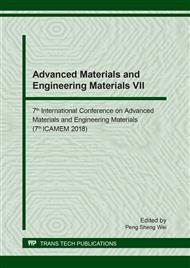[1]
R.H. Lumingkewas, H. Purnomo, G. Ausias, T. Lecompte, A. Perrot, D. Priadi, I. Katili, Properties of Indonesian coconut fibers for cement-based materials reinforcement, Proceeding, Third International Conference Natural Poly, Bio-Mat, and Gels, Kerala, India, (2012).
DOI: 10.4028/www.scientific.net/amr.742.92
Google Scholar
[2]
Onuaguluchi O., Banthia N: Plant-based natural fiber reinforced cement composites: A review, Cement and Concrete Composites, Vol. 68 (2016), pp.96-108.
DOI: 10.1016/j.cemconcomp.2016.02.014
Google Scholar
[3]
Lumingkewas RH., Ausias G., Lecompte T., Perrot A., Katili I., Purnomo H., S.P. Hadiwardoyo: Effect of fibers content on the tensile properties of coconut fibers reinforced cement mortar composites, Advanced Materials Research, Vol. 742 (2013).
DOI: 10.4028/www.scientific.net/amr.742.92
Google Scholar
[4]
Lumingkewas RH., A. Husen, R. Andrianus: Effect of Fibers Length and Fibers Content on the Splitting Tensile Strength of Coconut Fibers Reinforced Concrete Composites. Key Eng.Mat. Vol. 748 (2017), pp.311-315.
DOI: 10.4028/www.scientific.net/kem.748.311
Google Scholar
[5]
Lumingkewas RH, Purnomo H., Ausias G., D.Priadi., Lecompte T., Perrot A: Tensile Characteristics of coconut fibers reinforced mortar composites, Advanced Materials Research, 651 (2013) 269-273.
DOI: 10.4028/www.scientific.net/amr.651.269
Google Scholar
[6]
Wang W., Huang G: Characterization, and utilization of natural coconut fibers composite Material Design 30 (2009) 2741–4.
Google Scholar
[7]
Asasutjarit C, Charoenvai S., Hirunlabh J, Khedari J: Materials and mechanical properties of retreated coir-based green composites, Composites: Part B, 40 (2009): 633–637.
DOI: 10.1016/j.compositesb.2009.04.009
Google Scholar
[8]
Bachtiar D, Sapuan SM, Zainudin ES, Khalina A, Dahlan KZM: The tensile properties of single sugar palm (Arenga pinnata) fiber. IOP Conf Ser Mater Sci Eng Vol. 11 (2010), pp.1-6.
DOI: 10.1088/1757-899x/11/1/012012
Google Scholar
[9]
Razak HA, Ferdiansyah T: Toughness characteristics of Arenga pinnata fiber concrete, J Nat Fibers Vol. 2 (2005), p.89–103.
DOI: 10.1300/j395v02n02_06
Google Scholar
[10]
Ishak MR., Sapuan SM., Leman Z., Rahman MZA., Anwar UMK.: Characterization of sugar palm (Arenga pinnata) fibers, J Therm Anal Calorim Vol. 109 (2012), p.981–989.
DOI: 10.1007/s10973-011-1785-1
Google Scholar
[11]
Sahari J, Sapuan SM, Ismarrubie ZN, Rahman MZA: Physiochemical properties of different parts of sugar palm fiber. Fibers Text East Eur Vol. 20 (2012), p.23–6.
Google Scholar
[12]
ASTM C496. Standard test method for splitting tensile strength of cylindrical concrete specimens, Annual Book of ASTM Standards: American Society of Testing Materials; (2004).
Google Scholar
[13]
M.L. Sanyang, S.M. Sapuan, M. Jawaid, M.R. Ishak, J. Sahari: Recent developments in sugar palm (Arenga pinnata) based biocomposites and their potential industrial applications: A review, Renewable and Sustainable Energy Reviews Vol. 54 (2016).
DOI: 10.1016/j.rser.2015.10.037
Google Scholar


